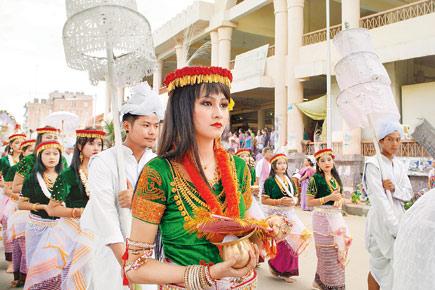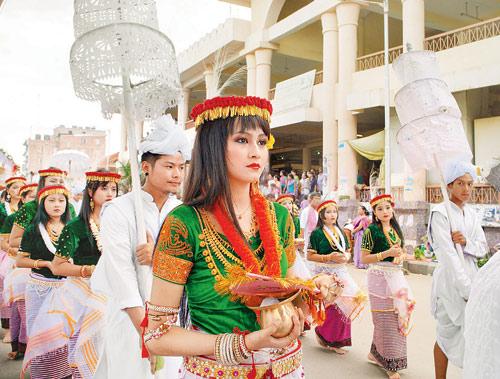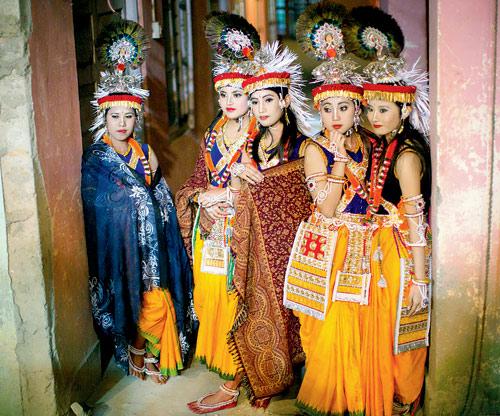Japanese-American documentarian Byron Aihara's new photo essay is a tribute to the rich and ancient cultural history of the Meitei and Chakpa communities

A Lai Houba procession at Khwairamband Bazar in downtown Imphal
Years ago, California-based documentary filmmaker Byron Aihara stumbled upon a YouTube video of a Manipuri singer named Mangka, which would alter his entire course of life. For Aihara, it was love at first sight. Not as much with Mangka, but her song. "That beautiful song she sang, cemented my resolve to make a trip to Manipur," he recalls. For the next two years, the Japanese-Amercian would immerse himself in his job as admissions advisor with CRC Health Group at Silicon Valley in California, saving every penny he earned. "Then, in 2013, I quit my job, bought a backpack, a pair of shoes and left for Manipur." He truly believed that in the heart of the Northeast Indian state, there was a story waiting to be told.

Byron Aihara
Three years on, he has managed to lend a voice to that story with Dance Music and Ritual in Manipur, a first-of-its kind in-depth photography book and cultural study on the indigenous faith and performing arts of Manipur.
The book, which emerged out of a 16-month-long self-funded research undertaken by Aihara, focuses on the Meitei and Chakpa communities of Manipur, who are the largest ethnic group of the state. While the photo essay centres around Manipur’s yearly festivals known as Lai Haraoba, it also touches upon their classical dance tradition, Ras Lila, and several aspects of the daily life and rituals of the hill tribes. "To the outsider, Manipur is still one of those unknown places. In my book, I write ‘...an air of mystery completely surrounds the subject. Whichever way one turns, accounts are under-informed, made exotic, sensationalised, or oversimplified.’ I wanted to see this mystery for myself," says the graduate of the UCLA School of Film and Television.

A Lai Houba procession at Khwairamband Bazar in downtown Imphal
Aihara, who has spent four-and-a-half years travelling extensively throughout India and Nepal for film documentary projects, maintains that when he reached Manipur, he had no clue how he was going to start his research. "Much of my stay was led by providence," he adds. One of the first people he met in the state was Somi Roy, the son of Padma Shree awardee MK Binodini Devi. "He advised me to go into the countryside to seek out the real musicians and elders," remembers Aihara.
But, it was when he met Mangansana Mayanglambam, the art director of Laihui, the centre for traditional and indigenous performing arts, that he made a major breakthrough in his research. "Mayanglambam is the father of Mangka, whose singing first inspired me to come to Manipur. He is intimately connected to the Lai Haraoba and the community of artistes, who animate the festivals. Through him, I met the inner circle of Manipur’s performing artist," says Aihara.

Students of the Nartanalaya Government Dance College of Imphal wait for their entrance during a recital performance of the Maha Ras
During his stay, Aihara shot over 40,000 photos and took over 100 hours of video recordings. "For the book, I edited it all down to just over 300 photographs, each with its own story," says Aihara, who raised funds for printing the book through a Kickstarter campaign early this year.
The filmmaker, who is now back in California, hopes that the book will help familarise the people of India and the world, with the rich culture of the communities of Manipur. "The Meitei and Chakpa peoples of Manipur have held on to their traditions and their unique indigenous faith. It is very much living and unbroken," says Aihara, adding, "I would travel to the end of the world to capture something like that."
 Subscribe today by clicking the link and stay updated with the latest news!" Click here!
Subscribe today by clicking the link and stay updated with the latest news!" Click here!










